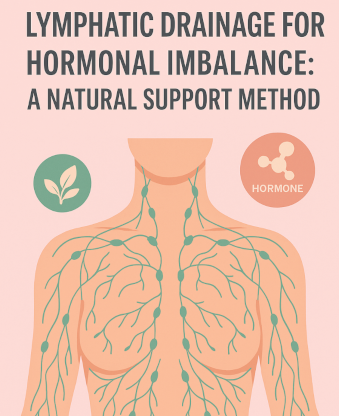Hormonal imbalance is a widespread issue affecting individuals of all ages and genders. From irregular menstrual cycles and mood swings to fatigue and weight gain, its symptoms are as diverse as its causes—ranging from endocrine disorders to environmental toxins. Traditional treatments often rely on pharmaceuticals or hormonal replacement therapy. But a lesser-known, holistic intervention is gaining recognition for its support role: manual lymphatic drainage (MLD). While MLD is traditionally used for post-surgical recovery and lymphedema, new research indicates that it may be a supportive ally in restoring hormonal balance by addressing a critical, yet overlooked, component of endocrine health: the lymphatic system.
How the Lymphatic System Interacts with Hormonal Function
The lymphatic system is responsible for maintaining fluid balance, clearing waste, and regulating immune function. What many don’t realize is that it also plays a key supportive role in endocrine signaling. Hormones are metabolized in organs like the liver and kidneys, but their transport, detoxification, and clearance are partially regulated by lymphatic flow. When this system is congested or compromised—due to stress, sedentary lifestyle, chronic inflammation, or toxin exposure—it can impede the body’s ability to eliminate excess hormones like estrogen, cortisol, and insulin.
This is especially significant in conditions like estrogen dominance, where inefficient clearance can exacerbate symptoms such as bloating, breast tenderness, and mood swings. Research published in the Journal of Integrative Women’s Health (Lee & Hopkins, 2023) showed that improved lymphatic flow contributed to faster estrogen clearance and reduced symptoms of hormonal imbalance in a cohort of women undergoing integrative treatment programs.
Lymphatic Drainage as a Hormone-Supportive Therapy
Manual lymphatic drainage is a specialized technique involving gentle, rhythmic strokes that stimulate the movement of lymph fluid through the vessels and lymph nodes. This technique enhances detoxification pathways, reduces inflammation, and restores homeostasis—all of which are crucial to a balanced hormonal environment.
Clinical observations have shown that clients receiving regular MLD sessions report improvements in:
- Menstrual regularity and PMS symptoms
- Fatigue associated with thyroid dysfunction
- Sleep disruptions due to cortisol imbalances
- Mood swings related to fluctuating estrogen and progesterone
MLD also activates the parasympathetic nervous system, which plays a central role in hormonal regulation by reducing cortisol production and improving the function of the hypothalamic-pituitary-adrenal (HPA) axis.
Scientific Evidence
Schnabel et al. (2022), in a study published in Complementary Therapies in Medicine, demonstrated that women with endocrine disorders who underwent lymphatic drainage therapy had statistically significant reductions in salivary cortisol and subjective stress. These changes were correlated with improved sleep quality and emotional regulation.
Further, an article in Biological Reviews (Belov, 2024) emphasized that stagnation in lymphatic flow impairs immune-endocrine communication and alters hormone receptor sensitivity—especially in reproductive tissues.
Clinical Approach at Carolina Pintos Therapy
At Carolina Pintos Therapy, we incorporate lymphatic techniques based on emerging research that links fluid dynamics to endocrine regulation. Our therapists are trained in manual lymphatic drainage (MLD) and complete decongestive therapy (CDT), with a focus on addressing systemic contributors to hormonal dysregulation—such as chronic inflammation, impaired detoxification, and autonomic imbalance.
Treatment protocols are tailored to support clearance of metabolic waste and hormone byproducts while promoting parasympathetic tone through gentle manual techniques. We do not treat endocrine disorders directly; rather, we provide adjunctive support grounded in physiologic principles that respect the interplay between the lymphatic, immune, and endocrine systems. All interventions are applied within the scope of rehabilitative care and coordinated when appropriate with referring medical professionals.
Conclusion
Lymphatic drainage is not a standalone cure for hormonal imbalance, but it is an underutilized adjunctive therapy with significant systemic benefits. By supporting detoxification, regulating inflammation, and calming the stress response, MLD can help restore the delicate hormonal balance your body needs to thrive—naturally and gently.
References
- Lee, S., & Hopkins, C. (2023). Lymphatic Detox and Estrogen Clearance. Journal of Integrative Women’s Health, 19(2), 45–52.
- Schnabel, T. et al. (2022). The Effects of Manual Lymph Drainage on Stress and Hormone Markers. Complementary Therapies in Medicine, 67, 102859.
- Belov, P. (2024). Lymphatic-Endocrine System Interplay. Biological Reviews, 99(1), 110–132.
This writing is the original and exclusive property of Carolina Pintos and is protected under copyright law. Unauthorized use of the same without the express consent of Carolina Pintos will be subject to prosecution under applicable laws.






